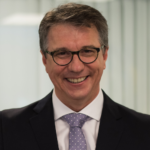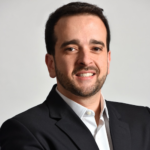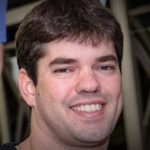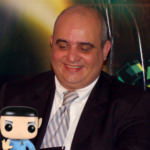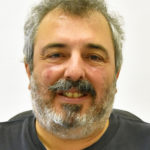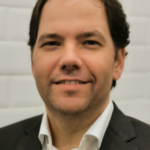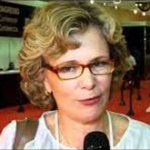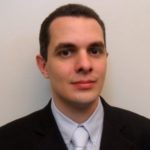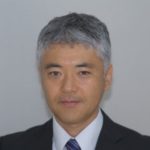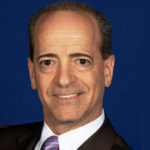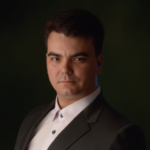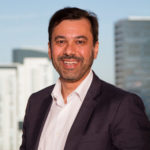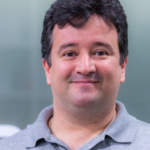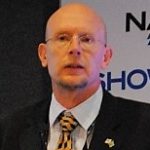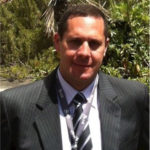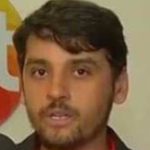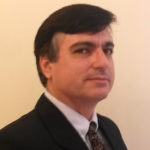|
9h20 - 10h40 | Audiovisual Contribution and Infrastructure |
Room 12
IP – Standards Update / Network Monitoring and Control
Increased complexity in IP-based systems and the growth in the number of audio, video, data, control and synchronism signals, often traveling on the same physical channel, make it imperative to use measurement and monitoring tools that assure compliance of these signals.This panel has experts on this topic, which involves standardizations of IP signals and their controls.
Chair: José Antônio S. Garcia - SET Deliberative Council / IP Study Group Coordinator
Technician in Electronics by ETE in Sta. Rita do Sapucaí in 1975 and Engineer in Telecommunications by Universidade São Judas in 1982. He has worked in television companies since 1975. Member of SET Deliberative Council - Technology Board, SBTVD Forum - Technical Module, UHD Brazil Project - Distribution Group and IP Study Group of SET - Coordinator.
SMPTE Standards enabling the live IP Transition
SMPTE IP standards for live TV production are maturing and are being adopted by equipment manufactures. What are the different SMPTE standards which are driving the media industries IP transition? How do they play together and what are they areas they apply to? Get an overview on SMPTE IP standards and how they play into a full stack implementation of IP infrastructure.
Thomas Bause Mason - Director of Standards Development -SMPTE
Thomas Bause Mason is the Director of Standards Development for the Society of Motion Picture and Television Engineers (SMPTE). At SMPTE he is responsible for maintaining the technical infrastructure for both the standards community and SMPTE home office. Bause Mason, formerly owner of Open Media Consulting, began his career in Cologne, Germany, as a computer programmer for automation software in the nuclear and automobile industries. Before his move to Los Angeles, Bause Mason worked at West German Television (WDR) and Cologne Broadcasting Center, where he led the quality control department. In Los Angeles, he became a postproduction consultant and then built and managed the encoding operations for Ascent Media. Joining NBCUniversal in 2005, he focused on emerging technology, spending two years in London to support the company's international business. Throughout his career, Bause Mason has assisted industry organizations in the development of standards, technical recommendations, and study group reports. He holds several patents and is a SMPTE Fellow.
Media Datacenter Orchestration and Management
Now that IP has firmly established itself as the new means of transportation for all types of media, broadcasters are facing the challenges of the change from SDI to IP, as well as the virtualization of infrastructure and the cloud, embarking on a new concept of Media Datacenter, something that makes it possible to provide a range of services and lots of flexibility, but increases the complexity with an infinity of flows, IP addresses, multicast and PTP. How can one have a complete overview of all the services and flows transiting through this datacenter, guaranteeing quality while avoiding package losses and bottlenecks? How does one orchestrate these services, extracting maximum functionality from this new structure and simplifying the operation? Come and give some thought to this, discussing it and more on our panel!
Fábio Acquati - Technology Director – NGN Telecom
Fábio began his career at Tektronix and has accompanied the evolution and transitions of video systems, participating in the early Digital TV tests in Brazil. He is currently a managing partner at NGN Telecom and works with network monitoring and management solutions, including video transportation. He is a member of the SET GEIP group, provides training and consultancy in the area, and continues to study technology with his partners, participating in implementations and proofs of concept, experiencing the challenges of the world of video.
In-depth view of LAWO’s System Monitoring & Realtime Telemetry; SMART
The unification of IP networks and broadcasting flows present a set of challenges to ensure that the media is generated, processed and delivered within the standards. IP flow can frequently experience packet loss, jitter, degradation from encoding and violations during transportation, to mention the bare minimum. For the success of the operation, it is imperative to use the correct monitoring and viewing tools to pro-actively identify the degradations and disruptions to the services.
Join us for an in-depth discussion of the Lawo Smart system.
Tony Zare - Product Manager - LAWO
Tony Zare is responsible for the technical and commercial success of LAWO’s SMART product range. He manages the component life cycle of the SMART product family, specializing in monitoring and telemetry of media infrastructure. Passionate about “big data”, correlations and now machine learning can be applied to current operations.
Tony has over 20 years of experience in the broadcast industry, where he began as a project engineer for ASIC high-sped integrated circuits, followed by 15 years in the development of onboard software and broadcast and network products. He holds a degree from the McMaster University in Computer Science and Mathematics, and is directing the strategy of the SMART (System Monitoring and Real-time Telemetry) family which he is positioning as the eyes and ears of broadcast networks, focusing on communication networks and media big data analysis.
IP Measurements
Monitoring of Equipment and Signal Flows on IP networks without compression, and Main Audio and Video Measurements on 2110-20 and 2110-30.
Eliésio Silva Júnior - Sales Manager – SEAL Broadcast and Content
With 26 years of experience in the fields of free–to-air and closed television, telecommunications and new media in (projects / monitoring of complex systems/ special events/ operations/ multidisciplinary/ sales team leadership) developed in major Brazilian and multinational companies, such as 17 years at Globosat –TV System and Operations Supervisor, 3 years at TV Globo –TV System Operator, 7 years at Tektronix – sales manager, 2 years at Seal – sales manager;
Eliesio has a Technological Specialization in Digital TV, Signal Compression and Quality - INATEL, MBA in Digital TV & New Media – UFF, a Graduate Degree in Logistics (Energy Supply/ Distribution Planning) – FGV, MBA in Business Management– UVA, an Undergraduate Degree in Electronics – FABES / Rio de Janeiro, and Specialization in Satellite-based Transmission – PUC Rio. He is also a Telecommunications Technician – ETRR / Rio de Janeiro and an Electronics Technician – ETRR / Rio de Janeiro
|
|
9h20 - 10h40 | Content Production |
Room 11
Online Content Production: A Market that grows Every Day
The change that online production has caused is enormous, and represents a new future for companies in the communications industry. Our guests will tell their experiences creating for different platforms of the online universe. Showing us the entrepreneurial and creative side of this market that has opened up new forms of business for the brands, new job opportunities for the professionals of the area and new formats.
Chair: Fernanda Siqueira Pinto - Production Manager, Digital AD for YTSpace Rio
Producer, screenwriter and director. I started at Globosat in 2000, where I participated in innovative projects such as the launch of Big Brother Brasil's Pay-Per-View channel, 3 Multishow Brazilian Music Awards and the Rock in Rio 3 broadcast. With Olympic Broadcast Service I acted in the broadcast of five Summer Olympics. And for two years I've been leading the operations of Youtube Space Rio, a creation and production space for youtubers, present in 9 capitals of the world.
Paulo Cuenca - CSO at WTF Maison
Since 2011 producing content for networks. Intern. Creative Director. Storyteller Consultant. Mentor. Top Creator. Channel Youtube Dani Noce
Antonio Tabet - Co-founder Porta dos Fundos
Carioca advertiser, actor, author, presenter and screenwriter. One of the founders of Porta das Fundo channel, Kibe Loco website creator and Flamengo's Vice President of Communication. Considered one of the 100 most influential people in Brazil by "Isto É" Magazine, one of the 15 most influential Brazilians on the internet by "GQ" and the most beautiful French and Lebanese descendant of Brazil by my mother.
Manuela Villela - Head Latam, Top Creator, Content Partnerships at YouTube
Villela has been with Google for almost 10 years, where she has gone through digital agency sales and management teams before landing in the content universe, leading YouTube Brasil's Top Creators and Public Figures team. Manuela is responsible for drawing the strategy to partner with the platform's endemic talent, making their channels increasingly relevant and mainstream. Recently added talent acquisition to this strategy off-platform, being responsible for the development of new channels focused on important names in the Brazilian creative scene.
|
|
9h20 - 10h40 | Audiovisual Contribution and Infrastructure |
Room 13
MAM: Digital Storage Challenges and New Business Opportunities
The exponential increase in content has raised the need for the deployment of new technologies for shared and high-performance storage, where the biggest challenge lies in combining workflows that promote more efficiency, security and availability.
While in the hitherto consolidated content preservation environment, we are encouraged to rethink cataloging concepts in the face of the advent of Artificial Intelligence.
When we look at the horizon the possibilities seem innumerable. But what will be the best technology for your business?
Chair: Juliana Ferrari - Media Manager - SBT
Professional with leadership in a Media Center environment coordinating operational workflows with security and efficiency in the movement and storage of digital assets. MBA in Project Management with PMI Practices - FIAP
Graduation in Social Communication - Radio and TV - Faculdade Oswaldo Cruz
PRESERVATION and ARCHIVES CURATOR: THE DIGITAL TRANSFORMATION and the BUSINESS OPPORTUNITIES
The bug did not happen, the machines did not stop. But the arrival of the millennium set a turning point for the audiovisual industry and the preservation of its contents in the digital age.
In the case of archive digital workflow we realized that the definitive change should be integrating the archive curator to the beginning of the production chain instead of keeping this role the traditional way in the end.
More than ever we need to enhance tools in technology systems and workflow to have access to the best results and preserve quality content to create new business opportunities.
The automation turned information quite “abstract”. The craft to the digital archive must keep the authenticity information concrete, continuing the storytelling of history and memory.
Rita Marques - Consultant - Director Owner of Garimpo
I am journalist by background, I have been working for 30 years in content management and audiovisual research.
From trainee to manager of Documentation Center – GLOBO TV CEDOC – I have learned to organize, preserve and retrieve relevant information and I have fallen in love with the transformation of memories in assets of audience.
In 1996 GloboNews premiere, our team has produced “ARCHIVE N”, a weekly program, which for 23 years informs and enchants the audience.
At the TV digital revolution timeline, I have managed together with the engineer’s team, the real time indexation project with on-line retrieve content distribution. An innovative workflow processing, perfomed with success and approval at “Football World Cup”, “Olympic Games” and “Rio de Janeiro’s Samba Parade”.
Nowadays I have opened and I am the director of Garimpo proper, a company with focus in audiovisual preservation and archives curator. I am part-time consultant to TV CULTURA, a company which I represent at International Federation of Television Archives FIAT /IFTA Executive Council.
The Rise & Impact of MAM: A Global Perspective
The concept of Asset Management has evolved quite a bit over the past few decades, but one thing has remained constant: content always was, continues to be, and always will be king. As a result of this notion, over the years content producers have looked for ways to innovate their methods of monetizing assets. The rise of MAM and its different applications, along with the broader trends of Big Data and Artificial Intelligence, enables content producers to both drive revenue growth and optimize costs by providing them with a platform that not only manages the information and content that is so crucial for monetization (driving revenue), but also presents the opportunity for streamlined and efficient operations (cost optimization).
Matt Silva - CEO of CIS Group Corp
Matt Silva earned a B.S. Business, Finance and Economics from the Stern School of Business - New York University. He has worked as an investment analyst at financial institutions such as CitI and Credit Suisse in N.Y. At CIS Group he served as Director of Corporate Development , COO and currently CEO.
Sony’s Enterprise Library Solution (ELS) System
This presentation will describe the technologies, features and capabilities of Sony’s Enterprise Library Solution (ELS) system. This is an enterprise class, scalable, high capacity data center storage solution, built on Sony’s Generation-3 Optical Disc Archive (ODA) Technology.
The latest Generation-3 ODA was designed to retain the well-known advantages of optical media storage while bringing performance, capacity and cost to very competitive levels. The use of multiple ODA media in a cartridge provides additional security and protection in library environments.
Details will be provided of the architecture of Sony’s ELS solution integrating advanced library robotics, WORM optical disc media cartridges and drives with seamless connectivity and management software, providing a highly secure platform for data preservation and archive of valuable digital assets.
To conclude the talk will address Sony’s Connectivity and System Management software platform for the ELS which provides an S3 data and RESTful API interface optimized for this new generation of Optical Libraries and Media, and to specifically address Cold Archive requirements. This full featured and standardized interface provides seamless integration with existing applications and infrastructure including Cloud and Hybrid configurations.
Hugo Gaggioni – Chief Technology Officer – Sony Professional Solutions Americas
Joined Sony in 1988. With research interests ranging from digital video and image processing and information theory to video/audio compression and multidimensional signal processing, Mr. Gaggioni has served as session-chairman of 13 international conferences in the areas of HDTV and bandwidth compression systems. He was a member of the Advanced Television Advisory group to the U.S. Federal Communications Commission (1987 to 1994). He is a Fellow of SMPTE and the recipient of the 2004 Leitch Gold Medal award for technology leadership. Mr. Gaggioni was chairman of the SMPTE technical groups on Digital Representation of the 1125/60 High Definition TV Standard (SMPTE 260M, 88-92) and Digital HDTV Serial Interfaces (SMPTE 292M, 93-96). He was also chairman for a SMPTE group on Editing of MPEG bit-streams for TV studio usage. Mr. Gaggioni represented Sony Corporation of America to the ANSI X3-L3 committee and the ISO/IEC MPEG coding group from 1988 to 1996. He has also given numerous presentations and tutorial courses on signal processing and advanced video technologies at international events sponsored by SMPTE, IEEE, and Eurasip organizations. He holds six patents and has authored 32 technical publications in the areas of video compression, digital filter banks and HDTV devices and systems. Mr. Gaggioni holds degrees in telecommunications, systems engineering, and electronic engineering from the University of Essex in Colchester, England; University of Pennsylvania, and Columbia University, respectively.
|
|
9h20 - 10h40 | Technology and Business |
Room 16
Media and Content Consumption in the Multiscreen Era
The panel aims to discuss the challenges and possibilities of communication in a universe where the consumer has total control of what to see, where to see and how to see. We will try to bring a holistic view, with an advertiser, a content producer and OOH platform to discuss this topic.
Chair: Guido Sarti - Head of Convergence at Globosat
A professional with over 10 years’ experience in Business Intelligence focused on Marketing. He is responsible for integrating qualitative and quantitative data in planning processes, UX/ID, media e and creative disciplines.
His track records consists of projects that enabled the development of strategies for clients like MasterCard, Itaú, Vivo, Google, Nike, RockInRio, RedBull, Natura and Netflix.
He began his career at R/GA as soon as the agency entered the Brazilian market, always in the universe of data and analytics, and he has been using data to enhance the efficiency of processes and strategic capabilities by developing creative solutions.
He worked on the launch of Nike Fuel, a project that expanded the sales and awareness of the Nike brand among its consumers, and was also involved in the re-launch of Perfumaria Natura, a project that led to the recovery of the position of the world’s most pulverized perfumery market.
Raphael Jimenez - National Advertising Director at Elemidia
Elemidia's National Advertising Director, Raphael Jimenez holds a degree in business administration from PUC SP and an MBA from FGV. He has been with Elemidia for 15 years and previously worked for companies such as Citibank, Credicard and Bradesco.
Today he leads a sales team of 30 people and is 38 years old!
Rafael Gonçalez - Executive Manager of Integrated Media at BRF
Marketing executive, media specialist with track record in major ATL agencies and, since August 2018, responsible for the entire content distribution strategy at BRF.
|
|
11h - 12h20 | Audiovisual Contribution and Infrastructure |
Room 12
IP Infrastructure – Early Adopters’ Challenges (Case Studies)
Outstanding Engineers from four leading TV companies present their experiences in cases of IP infrastructure – based deployment in their institutions.
We select cases with different types of applications such as: HD Baseband /4K Baseband / Video Compressed in H264.
The speakers will address various aspects of their projects, such as:
- Types of applications that deployed with IP Infrastructure;
- Factors that led to the choice of IP technology;
- Type of IP solution adopted;
- Critical points in the design and definition of the solution architecture;
- Pros and cons of the IP solution over a conventional solution;
- Critical points in the implementation and setup;
- Adaptation of operational and professional routines;
- Results obtained;
- Macro project evaluation in technical, operational and cost terms.
Chair: Carlos E. O. Capellão - PHASE Engenharia
Electronic Engineer graduated from UFRJ in 1974.
MBA from FGV-RJ.
Since 1973, he has worked in the television and telecommunications sector, working in main TV Networks and at Embratel.
In 1980 he founded PHASE Engenharia, a company he has been directing since then, working on the design and implementation of Television Equipment and Systems and
Telecommunications. In Phase, he is constantly improving a wide range of Solutions for TV projects through partnerships with manufacturers leaders in their segments.
Founding partner of SET - Sociedade Brasileira de Engenharia de Televisão, occupied the positions of President and Director for many years.
Sky - TS-H264 at Jaguariuna
Alexandre Hotz - Director of Engineering at Sky Brasil
Electronic Technician from Fundação Bradesco, Technologist in Electricity from Universidade Presbiteriana Mackenzie, Electrical Engineer from Pontifícia Universidade Católica de São Paulo, post-graduate in Digital Satellite TV System from INATEL and master in Electrical Engineering from USP.
He has 25 years of experience in various areas of Electrical Engineering, Information Technology, Telecommunications Systems, Television Engineering and Technical Education at the intermediate level.
He works as a Director of Engineering at Sky Brasil where he is responsible for the development of RF and satellite projects, Critical Mission Infrastructure, Set-top box and ODU development, and IP Network Infrastructure within the Engineering Department of SKY.
Globosat - Band Base in Rio headquarters
Alexandre Torres - Manager of Technology Development at Globosat
Electrical Engineer - Emphasis in Electronics.Graduated from the UGF, postgraduate in Communication Networks by PUC-RJ and Training in Executive Management by COPPEAD.He has been working for 30 years in the Media and Entertainment area, started his career in TV Manchete, currently holds the position of Technology Manager at Globosat, responsible for projects related to Playout and Content Production.
TV Globo - HD and 4K Baseband in Rio and Recife
Wilson Almeida - Executive Supervisor of TV Systems Support at TV Globo
Telecommunications Engineer with an MBA in Network Management and Internet Technology at the Electronic Computing Unit of the UFRJ.
He has been active in the Television segment since 1994 and is currently the Support Executive Supervisor, coordinating 4 specialist sectors: Video Systems, Audio Systems, Graphics and Editing Systems and Mechatronic and Lighting Systems.
He has taken part in highly relevant events, always focusing on innovation like coverage of the World Cup, the Olympic Games and Carnaval; besides major projects like the new set for Jornal Nacional, the Mobile Unit 7 – the world’s first 4K IP Mobile Unit and Globo’s new shooting module, the MG-4, completely in IP.
|
|
11h - 12h20 | Audiovisual Delivery |
Room 11
SMPTE – Standards Update
Chair: Paulo Henrique Castro - Technology and R&D Director / TV Globo
Engineer by the Pontifical Catholic University of Rio de Janeiro in 1996 (PUC-Rio). Working with Globo since 1996, where started on an internship program.
Responsible for the standardization of the Digitial TV in Brazil. -Coordinator of the Audio and Video Coding Working Group of the SBTVD Forum. -Chairman of the ABNTCommitee for Digital TV (Associação Brasileira de Normas Técnicas, Brazilian ISO Branch). -Contact point for Subgroup A – Specifications, on the Brazil-Japan Joint Work Group for Digital Television iniciative -Member of SET (Sociedade Brasileira de Engenharia de Televisão) since 1996. Also a member of many societies of IEEE(CommSoc, BTS, MTT, CE) and SMPTE
Pat Griffis - President of SMPTE / Vice President Technology, Office of the CTO at Dolby Laboratories
As Technology Vice President in the CTO Office at Dolby, Patrick Griffis is charged with helping define future technology strategy for the company which includes identifying and tracking key technical trends, performing technical due diligence, and supporting advanced technology initiatives for the company. He has been an active company spokesperson on the topic of next generation imaging and in particular, “better pixels” - a term he coined for High Dynamic Range plus Wide Color Gamut. Before joining Dolby, Pat spent 10 years at Microsoft leading global digital media standards strategy, including adoption of the Digital Living Network Alliance as a baseline media sharing standard in Windows 7 and standardization of Windows Media Video technology as an international SMPTE standard. Prior to Microsoft, Pat spent 15 years at Panasonic in senior management positions, including Vice President of Strategic Product Development at Panasonic Broadcast where he drove Panasonic’s HDTV strategy for the US. Pat started his career at RCA, earning eight patents in TV product design.
SMPTE Standards Deep Dive
Get an update on the SMPTE standards organization, current standards development efforts in SMPTE and learn how SMPTE standards development is adapting to the evolving technology landscape. As new technologies are introduced SMPTE has to transform its standards development process and support the move to more software based and IP based approaches. What SMPTE standards are supporting new image and audio formats, the underlying infrastructure and the new applications needed in the industry? How does SMPTE, as a global organization, interact with other industry organization worldwide?
Thomas Bause Mason - Director of Standards Development -SMPTE
Thomas Bause Mason is the Director of Standards Development for the Society of Motion Picture and Television Engineers (SMPTE). At SMPTE he is responsible for maintaining the technical infrastructure for both the standards community and SMPTE home office. Bause Mason, formerly owner of Open Media Consulting, began his career in Cologne, Germany, as a computer programmer for automation software in the nuclear and automobile industries. Before his move to Los Angeles, Bause Mason worked at West German Television (WDR) and Cologne Broadcasting Center, where he led the quality control department. In Los Angeles, he became a postproduction consultant and then built and managed the encoding operations for Ascent Media. Joining NBCUniversal in 2005, he focused on emerging technology, spending two years in London to support the company's international business. Throughout his career, Bause Mason has assisted industry organizations in the development of standards, technical recommendations, and study group reports. He holds several patents and is a SMPTE Fellow.
|
|
11h - 12h20 | Audiovisual Contribution and Infrastructure |
Room 13
Content Playout: Case Study, Technological News, Multisite and Multiplatform
This panel will deal with issues involving Technology for content delivery on different platforms: Linear and Non-Linear TV and the evolution of the models that can be applied. IP, 4K, Virtualization and the Cloud will all be on the menu, indicating the status and roadmap. Solutions already implemented will be presented using relevant case studies. Some of the issues to be covered:
- What have clients adopted on a global scenario? On the Linear and/or Non-linear TV scenario.
- What are the challenges in operating the new technologies?
- What is the menu of solutions available, conceptually speaking, from IP, 4K, virtualization and the Cloud, and which is worthwhile in each case?
- What are the new solutions capable of delivering?
- When is it worth migrating/updating display infrastructure?
Come and join us, clear up your doubts, we will have panelists who are experts in the subject at your disposal.
Chair: Carlos Cauvilla - Director of TV Technology at Anhanguera Network
Engineer with an MBA in Business Management and Technology Management. Currently holds the position of Director of TV Technology at Anhanguera Network, where he is responsible for the operation, projects and implementation of technologies aimed at the Media TV business.
Broadcast Playout - The New Master Control Migration
Master Control has always been an integral function for a successful Television Broadcast. Since it's origins it has been in a state of flux and evolution. As the industry has matured, Master Control has evolved and grown to take on and manage the ever increasing complexities needed to composite the image and make it consistently air ready. Continuity within this last “gate post” is highly important because it is the last opportunity in the broadcast chain which guard the cash register. I remember the days of missed event reports, make good reports and lost content reports. We all hope these uncomfortable followup meetings have become a thing of the past, that the Cash Flow is protected and actual viewership numbers can be collected to support advertising rates. This paper is about the migrating master control utilizing IP and other technologies to move forward.
David Russin - VP Sales for the Americas, Pebble Beach Systems
David Russin is Pebble Beach Systems’ VP of Sales for the Americas region. Having previously held positions at Grass Valley, Harris Broadcast, Omnibus and Masstech, Russin brings over 35 years of experience selling automation, automated workflow and infrastructure solutions. Highly customer focused, he is committed to helping broadcasters to solve their challenges and find the right solution for their evolving playout needs. As a second-generation broadcast technology professional, Russin has television technology in his DNA. David holds a University Degree in Communications from the State University of NY at New Paltz, NY.
Playout: what are the challenges and evolution
What are the playout and distribution areas on a TV station? What are the challenges and the evolution for the traditional distributions and on the new platform (OTT and VOD)? How those items were dressed on the new playout area at TV Globo installations.
Filipe Fernandes Forte - Operational Manager of Exhibition and Distribution of TV Globo (RJ)
Filipe Fernandes Forte holds a degree in Electrical Engineering, specializing in Electronics, from the PUC/RJ, an MBA from UERJ and a graduate degree from Coppead. He currently holds the position of operations manager at Rede Globo (RJ).
Positions held at the company:
From 2004 to 2013, he worked in the projects area of TV Globo, having gone from intern, Projects Engineer I, Projects Engineer II, and Projects Engineer III to Projects Coordinator. These positions gave him the opportunity to work on across-the-board projects in the company: Entertainment, Journalism, Sport and events. Beginning 2013, he worked as Operations Manager at Globo Internacional and, in 2014 he took over the Transmission and Distribution Department at Globo in Rio. Here, he was responsible for managing the entire Globo transmission hub, with signals from the Globo network, delivering content and commercials to the 122 affiliates, Globo Rio, the company’s second-biggest market, and Globo Internacional with its 6 channels for the overseas market.
|
|
11h - 12h20 | Technology and Business |
Room 16
Blockchain in the Media and Entertainment Industry
Do you know what Blockchain is?
Do you know how Blockchain is being used to transform the media and entertainment industry?
Get to know the full potential of Blockchain and its ability to transform how media content (music, video and other forms of entertainment) are delivered, consumed and paid through digital ecosystems.
Chair: Vinícius Vasconcellos - Senior Consultant - Telecom, Media & Entertainment IBM
Vinicius is a Senior Consultant at IBM, with focus on the application of new technologies such as Artificial Intelligence, Blockchain, Cloud, Big Data and Analytics in the Telecom, Media and Entertainment industries. With solid telecom and broadcast experience, he served as a specialist and executive at Claro and Grupo RBS. He holds a degree in Electrical Engineering and specialisation in Administration from UFRGS and an MBA in Executive Management from Fundação Dom Cabral.
What is Blockchain for Business?
Blockchain for Business: Fundamental concepts, history and present.
Mauricio Magaldi Suguihura - Community Coordinator, Hyperledger Chapter Brasil
Graduated as a Production Engineer from UFSCar – the Federal University of São Carlos, and holds a graduate degree in Finance from the FIA – Fundação Instituto de Administração. He is currently working on projects for the transformation of business using Blockchain and other disruptive technologies, plus his professional experience of almost 20 years heading up different projects for financial market companies like Banco Santander, Banco Safra, Citibank, Banorte, HSBC. In addition to Blockchain, his fields of specialization are Data Governance and Business Process Transformation.
How blockchain can collaborate with the Media & Entertainment Industry
Blockchain is currently one of the most hyped technologies. Its ability to share a single, immutable set of records could be transformational in the media and entertainment industry. It can help provide transparency, trust, efficiency, speed, and security across a wide range of contexts, from content distribution to advertising. For instance, to mitigate ad fraud and copyright infringement. Let's discuss a solution that provides visibility into ad placements and ensures ads are seen and engaged with by human beings and not bots.
Luiz F. Jeronymo - Director Sales Engineering at R3 Brazil
Responsible at R3 for the engagement of clients in architecture solutions using blockchain technology and in the development of new business. He was the blockchain technical leader and a solution architect at IBM Brazil, having contributed to several transformation projects and the adoption of new technologies. He has more than 25 years of experience in Information Technology. Graduated in Electronic Engineering from the Federal University of Itajuba, he holds an MBA in IT Management from FIA and a Masters in Information Systems and Business Organization from IAE - Pierre Mendes University in Grenoble.
Blockchain as Transparency Vector in Media, Entertainment and Advertising
Digital media have changed the world of consumers, artistes and advertisers. Even so, major challenges remain, and others will arise. The US economy loses $12.5bi annually through pirating of music. Fraudulent on-line ticket sales are now double when compared with printed tickets, while digital advertising fraud costs the economy at least $19bi annually.
Come and find out how we can achieve total transparency in digital transactions by creating an environment of trust, reducing costs and eliminating the middlemen.
Washington Cabral - Technology Advisor for M&E IBM
In the Information Technology market since 1988, in 2013 I turned to developing knowledge of relevant contribution to the media and entertainment sector, working as a solutions architect on initiatives like Over The Top (OTT) transmission in virtual reality of Rock in Rio 2017 or speaking at events like the North American Broadcasting (NAB show, Las Vegas), SET Sul (Southern region) in Curitiba and Porto Alegre and the e Southeastern region (Rio) and SET EXPO (São Paulo). I intend to continue doing so in years to come.
|
|
| SET Tech Break |
LAWO
 This presentation will provide an insight into the experiences learned by several broadcasters who were early adopters of IP technology over the last few years. The presentation will focus on live sports production applications using outside broadcast (trucks) as well as remote production and large stand-alone facilities. This presentation will provide an insight into the experiences learned by several broadcasters who were early adopters of IP technology over the last few years. The presentation will focus on live sports production applications using outside broadcast (trucks) as well as remote production and large stand-alone facilities.
IP Infrastructure - Pioneer Challenges (Case Study)
This presentation will provide an insight into the experiences learned by several broadcasters who were early adopters of IP technology over the last few years. The presentation will focus on live sports production applications using outside broadcast (trucks) as well as remote production and large stand-alone facilities.
Erling Hedkvist, senior vice president and business development manager at Lawo
Mr Hedkvist has been in the broadcast industry since 2000 and started his career in product management before making the move over to sales, business development and corporate management. Mr Hedkvist specialized early on in providing networking solutions for the broadcast and media & entertainment industry. Initially for contribution applications but lately with a focus on providing software defined networking solutions for live production workflows. As such he works with clients to design complete solutions for Remote Production, Master Control, Playout, PCR, OTT and other broadcast applications on top of IP and in a distributed and virtualized environment. Mr Hedkvist has presented at several prominent industry forums such as SVG, VSF, WBU-ISOG, SSPI and others and holds a Master’s degree in Computer Science and Engineering with a specialization in Computer Communication from Lulea University of Technology in Sweden.
|
|
14h - 15h20 | Audiovisual Contribution and Infrastructure |
Room 12
IP – Integration of Technologies for Traffic of the Signals in Different Areas
Today’s IP technologies for traffic of broadcast quality content must provide the means to meet needs and to leverage the creativity. Creativity and need are pushing new developments, but individually the current solutions are not giving all the answers and hybrid solutions are starting to take up space. This panel presents the possibilities of integrating current IP technologies in different areas, in search of better and more efficient uses for each case.
Chair: Leonel da Luz - President, Media and Content Dynamics
Leonel da Luz is the president of media and content-dynamics that serves the Brazilian and Latin American markets, offering consulting, projects, products and professional services. With a solid background in engineering and business management from Mauá, INATEL, FGV and MIT, Leonel has accumulated success stories in several national and international companies such as TV Cultura-SP, Ampex, Philips, TV Anhanguera, Harris and Grass Valley, among others.
Could you produce it faster and cheaper? (My boss asked)
The world is changing rapidly. The way we collaborate between one Department to another is challenging everyone to get it done faster and cheaper. The IP hasn’t only changed Phones System or Voice, it’s also changed the way we distribute the video from one point to another, by fiber, by satellite or even by WIFI. I’ll explain how we changed the way that an entire TV Network, in a small Country named El Salvador, distributed video to the entire world.
Raul Dominguez Martin - CEO, PR Media
Raul Dominguez, executive producer, born 35 ago in Spain. He started as a television presenter with only 12 years old. He studied at LACC and UCLA in Hollywood, California.
Raul has been responsible for the creation of innovative digital platforms with mostly impacting Central America, producing dozens of programs endorsed by NBC Universal, Sony or Endemol Shine.
He is a frequent panelist on the Future of Television in NexTV CEO in Miami and judge of the PRODU AWARDS at the NAB in Las Vegas.
Ensuring video delivery quality in an IP world
There are big challenges when dealing with video delivery that goes over third party IP networks and CDNs. The best scenario for an operator is to have a platform that monitors the video delivery content from the head end till the last mile, with a centralized management system that can correlate all alarms and can quickly pinpoint the location and cause of the failure. These solutions ensure the end user’s satisfaction and also make sure that 3rd party companies that are being paid to store, prepare and deliver such valuable content are doing their job well
Bruno Bellantuono, Director of Sales and Business Development - South Cone, Telestream
Computer engineer graduated with 14 years of experience in Digital TV, OTT and IT projects within leading technology providers. Implementation / sale of turn-key and specific projects encompassing headends, conditional access (CAS), middleware, set-top boxes and video quality monitoring (QoE / QoS) solutions.
Orchestrators for Video over IP Infrastructures
The IP infrastructures for video are based on very reliable routers. Routing can be fully controlled by an external software layer called Orchestrator, in the Software Defined Video Network concept, which manages signal routing, port configuration, redundancy mechanisms, bandwidth, faults, and auto discovery of devices, such as gateways with the SDI legacy. A good orchestrator is critical to the smooth, simple and reliable operation of an IP video installation.
Guilherme Castelo Branco - Partner Director / Phase Engenharia
Bachelor in Electronic Engineering from UFRJ, with specialization in business management from Fundação Getúlio Vargas - SP, has worked in the area of solutions for television systems since 2004. He is currently the director of Phase Engenharia in São Paulo.
The largest IP project of the world. And lo, the new facility came to challenge
There is no question about it, our industry is moving to IP. Around the world the majority of new projects are IP based.
It is not hard to find one to talk about but CBC/Radio-Canada is deploying the largest IP project in the world.
From when the construction started 2 years ago all the way to the on air date, this case study will be showing the chosen architecture and some of the challenges that they encountered.
Welcome to the CBC/Radio-Canada case study.
Denis Paré - VP Sales / Embrionix Design
Denis Paré is Vice President of Sales of Embrionix Design, responsible for all direct sales and reseller channels worldwide. He is also entrusted to grow strategic customer accounts and partner relationships in the broadcast market.
Denis brings a broad range of experience to the Embrionix sales team, including executive sales positions at Miranda Technologies and Grass Valley, where he worked as Director of Sales, Americas and Director of Strategic Accounts. Prior to joining Embrionix, Denis spent over 20 years in video broadcast industry.
|
|
14h - 15h20 | Audiovisual Delivery |
Room 11
OTT Streaming: Challenges, Technologies, Services for building the Next Generation of Viewers
TV stations and operators based on traditional models are facing the challenge of having to win over new viewer while retaining their existent bases, given the progressive and inexorable change of habits in the way videos are consumed.
The appearance of new players operating with OTT streaming has had a huge impact on the entire media and entertainment sector market, with forecast global revenues of US$ 64,78 billion in 2021, of which approximately US$ 3,59 in Latin America (Digital TV Research Forecasts/2018).
The fallout from this challenge is easily measured: in the subscriber TV sector alone, between November 2014 and May 2019 there was a loss of 2,9 million subscribers (ANATEL/2019). The decline in free-to-air TV audiences prompted the leading stations to launch their own streaming services in recent years in an effort that has required a speed of response from organizations which, from a cultural point of view, are slow to react, , almost always using the same ecosystem of traditional suppliers in an attempt to bring about change amidst a disruptive setting.
In this panel. We will discuss the scenario of the experiences in supplying OTT streaming, highlighting the challenges technologies, business model, services and innovations that are helping to be build a quality experience for users in a scenario where companies need to be strong competitors (while at the same time collaborating with each other.
Chair: Salustiano Fagundes - CEO - HXD OTT Solutions & Owner HIRIX Software Engineering
Entrepreneur in the area of technological innovation, founding partner of HIRIX Software Engineering and HXD Smart Solutions, a company that since 2007 has been "thinking and making the new television in Brazil". He is a member of SET Deliberative Council. He is a guest researcher at CITI (Interactive Center for Interactive Technologies) and LabArteMidia-Laboratory of Art, Media and Digital Technologies, both from the University of São Paulo (USP) ; and Ambassador of Campus Party, an organization that brings together a worldwide community of developers and makers with a mission of "building a new source code for the world."
HbbTV as an efficient alternative for providing multimedia and interactive OTT content delivery: overview, cases and strategies
The DVB standard, which pioneered the transition from analog to digital and SD to HD / UHD, has been exploiting the full potential of IP-based and RF-based broadcast hybrid delivery for connected TVs, set-top boxes and HbbTV-enabled multiscreen devices that enable broadcasters and operators to explore new services, including making OTT audio-visual content delivery as easy as on classic platforms
Technologies for the transmission and delivery of hybrid media, including DVB-T2, DVB-DASH and DVB-CSS, complemented with HbbTV-based services, are already in use in many countries inside and outside Europe and are becoming a alternative for traditional players to position themselves in an increasingly disruptive, interactive and competitive market.
In this session we will have an overview of how HbbTV is being used, know some success stories and their strategies for the future.
Stan Baaijens - DVB Chair PCM & Steering Board (CEO, Funke Digital TV)
Stan Baaijens is a second generation owner of Funke Digital TV after following his father’s footsteps by joining the Funke Company almost 40 years ago. Since 1992 his focus laid on understanding consumer needs, the broadcasting industry and the increasing market penetration of digital TV and by doing so Funke Digital TV was able to anticipate future market needs and opportunities. Nowadays, his mission is to build state of the art digital terrestrial reception solutions and deploy these extensively around the world. In 2015 Mr. Baaijens was appointed as DVB Steering Board member and since 2018 elected as Chairman of the DVB Promotion & Communications Module (PCM) at the EBU in Geneva. As a Steering Board member, Stan represents CE manufacturers within DVB and will strongly support the interest of CE manufacturers of Digital TV products by making use of his extensive market knowledge and network.
Five Steps – Machine Learnig & Artificial Intelligence for Delivering Streaming
The world is overflowing with digital media. As media executives, you’ll need to make sure viewers can find and play your content easily. This presentation is my top five list of how machine learning (ML) and artificial intelligence (AI) will help you design a better viewing experience, maintain technical best practices, plus at the same time make sure you can still run a profitable business.
Nadine Kerfatz - OTT Management Consulting & Founder Reality Software
Nadine is an industry expert in business models and technologies for OTT and help media and technology companies win customers with everything needed to build digital video and the next generation TV experience: the tech, business and design. She has a great experience with manage projects, define strategy and write about innovation for industry publication Streaming Media Magazine.
Building and Evolving a Streaming OTT Platform in Brazil: An Overview of Technology, Regulatory, and Business Challenges
Building, maintaining and developing an OTT Streaming service in Brazil that provides a quality experience with diverse content has been a huge challenge that Encripta decided to embrace in 2015, when it launched a platform for distribution and delivery of movies and series – Looke, which uses business models based on SVoD (subscription) and TVoD (transactional) and was the first streaming platform in Latin America to offer video downloads offline.
In this session, we will find out about the experience of the entrepreneurs of Looke who, rowing against tide of a series of obstacles encompassing high risk for those investing in innovative technologies in Brazil, including regulatory uncertainty and the growing competitiveness of the Brazilian market with the arrival of new players, managed to establish a foothold and occupy new spaces.
Luiz Bannitz - Business Director of Fitness Channel | Encrypt | Looke
Luiz Bannitz is an economist, lawyer and business administrator. His passion for bridging history and technology led him to strategic positions at companies such as HBO Brazil, EMI Music and GEO Eventos, where he worked as a director. He is currently Director of Business for Fitness Channel, Director of Business Affairs at Encripta and Director of Business and Content for Looke.
The pay-TV industry is in the midst of tremendous disruption
New technologies are allowing for an unprecedent number of services, and for very fast deployment schedules. Globally, media consumption is rapidly growing and disrupting the traditional ways of securing, monetizing, and delivering video content and its associated services. This new environment requires operators and media companies to leverage existing architecture investments to deliver a range of offerings to consumers, from entry-level to premium services. At the same time, when and if economics begin to shift and allow for renewed architecture investment, a transition to the cloud should be considered. This session will engage in a transparent discussion on finding the right balance when blending broadcast and IP delivery.
Fabio Souza - Solutions and Marketing Latam - Synamedia
Fabio is a technology executive and entrepreneur with a strong bias to execution, combining 20 years of experience in start-ups, consulting, media, service provider, and technology companies including DirecTV Group, NET Brasil (part of America Móvil) and GVT (acquired by Telefonica), lastly at Cisco driving the transformation team of the Video Business. At Synamedia since October 2018, he is heading LatAm strategy, marketing programs, products, and partners.
|
|
14h - 15h20 | Technology and Business |
Room 13
Pay TV – Technology and Services in the Streaming Era
As OTT services are growing , the PayTV industry is in rapid transformation, becoming a converged entertainment media hub, supporting multiple formats, devices, and fully personalized. The purpose of this panel is to share the experience of key executives who have participated and actively contribute to such evolution, highlighting the strategies adopted by major Pay-TV operators worldwide.
Chair: Claudio Borgo - Digital TV Engineering Director - Claro Brasil
Javier Garcia - Head of Sales for Latin America | Verizon
He has constructed and deployed highly complex technological process & solutions that have manifested in businesses in generating more revenue, controlled expenses and effectively and efficiently be safer and more secure. In 2013 he laid the entire framework for what is known today as the VDMS Latin America Region. In 2011 prior to joining VDMP, he was a Sales Director for the West Region at Verizon Wireless. During his tenure here he restructured the sales organization in order to effectively improve performance and deploy the go-to-market strategy for complex mobile products.
Gabriel Mandelbaum - CEO and co-founder of Spideo
Gabriel Mandelbaum is CEO and co-founder of Spideo, the personalization toolbox for creative industries.
Before founding Spideo in 2010, Gabriel was head of Digital at Zodiak Entertainment, a leader TV production company (now part of Banijay group), in charge of web, mobile and new media production and distribution.
With his co-founders, Gabriel decided to create Spideo in order to provide powerful content discovery tools to broadcasters and Pay-TV providers, as their universe started to change, facing the streaming revolution.
When he’s not travelling the world, meeting customers and negotiating new deals, Gabriel is in Paris, his hometown and headquarters, along with his team and family.
Gary Brust - Director of sales, Latin America & Caribbean - Irdeto
Gary Brust is a veteran of sales and marketing in the global Telecom and Service provider industry segment. Starting at Scientific-Atlanta(sold to Cisco) he opened the cable TV products market For S-A in Latin America in the early 90's and then ran ADC sales for LatAM as its RVP. Subsequently Brust alternated between C-Level roles in North America at Terayon and Concurrent to business development and product roles, LatAM focused at Arris and Cisco - both as consultant and employee. Prior to joining Irdeto as Director of LatAM sales, Brust led sales and marketing for Deep Fiber Solutions. He holds a BS ISyE from Georgia Tech and attended the University of Belgrano in the MBA, Strategic Management program.
|
|
14h - 15h20 | Innovation and Disruptive Technologies |
Room 16
Audiovisual delivery in 4G / 5G
One of the biggest breakthroughs in the audiovisual distribution industry is related to the use of 4G and 5G mobile phone networks. For now, the big question to be solved is how to establish the convergence between broadcasting and broadband. The panel will have five speakers: Professor Brito will explain in a didactic way what 5G technology is, where he will work, what its advantages over the others and its potential for several segments of telecommunications. Vandoros, in turn, will show the project of the European Broadcasting Union (EBU), to which Eurovision is linked, for the transmission of audiovisual content using the 4G/5G. In closing, there will be three case studies: a point-to-multipoint transmission test being conducted in Germany with the 4.5G, to be presented by Aziz; and low latency, augmented reality and 4K/8K virtualized UHD 8K point-to-point Hyper-Video applications by Driesen and Pilati, respectively.
Chair: Cristiano Akamine - Professor, Universidade Presbiteriana Mackenzie
Cristiano Akamine received the Ph.D. degree in electrical engineering from the State University of Campinas, Brazil, in 2011. He is a Professor with Mackenzie Presbyterian University, where he is a Coordinator of Digital TV Research Laboratory. He is a member of the Board of the Brazilian Digital Terrestrial Television Forum and Society of Brazilian Broadcast Engineers (SET). He works in the ISDB-TB broadcasting standardization and holds several patents, licensing of intellectual property, numerous articles published and has a Brazilian scientific grant of Productivity and Technological Development and
Innovative Extension—Level 2 from the National Council of Technological and Scientific Development. He has also served as a reviewer for several periodicals and conferences and has participated as a Guest Editor in the Special Issue Point-to-Multipoint Communications and Broadcasting in 5G of IEEE Communications Magazine and the Special Issue on 5G for Broadband Multimedia Systems and Broadcasting of IEEE Transactions on Broadcasting. He currently serves as an Associate Editor of IEEE Transactions on Broadcasting.
His research currently focuses on digital terrestrial broadcasting, software-defined radio, channel codes, embedded systems, and 5G.
Broadcasting and 5G - EBU/ES View
This panel aims to give an overview on the EBU studies for 5G and the main applications from remote production to final distribution.
João Vandoros - Consultant, EBU
Joao Vandoros is in charge of Eurovision Services in Brazil, the operational company of EBU. He is post-graduated in Telecommunications by Unicamp and got his bachelor degree as Electrical Engineering at Mackenzie University. Since 2000, has been working in Broadcasting Engineering, focusing his carrier in the content contribution and distribution segment.
5th Generation of Mobile Communications Networks - Challenges, Opportunities, and Threats
The fifth generation (5G) of mobile communications networks promise to revolutionize the telecommunications sector, offering scenarios of use hitherto not contemplated in previous generations. In this presentation, we discuss the scenarios of use expected for 5G networks, defining their performance requirements and typical applications, as well as the technological trends for the standardization of these networks. Also, we discuss the challenges for the implementation of 5G networks, as well as the opportunities and threats they can bring to the various segments of telecommunications.
Jose Marcos Camara Brito - Professor, INATEL
José Marcos C. Brito received the B. S. degree in electronic and telecommunications engineering from National Institute of Telecommunications (Inatel), Brasil, in 1986 and the M. Sc. and Ph.D. degrees from Campinas University (Unicamp), Brasil, in 1998 and 2003, respectively, both in electrical engineering. He has worked as a professor at Inatel since 1986, since 1990 as a full professor. He has occupied several management positions at Inatel: General Manager of Research & Development Center, Post-Graduation Coordinator, Research & Post-Graduation Director, and General Vice-Director. Currently, he is the Research & Post-Graduation Director at Inatel, the General Coordinator of Radiocommunication Reference Center at Inatel, the Secretary General of 5G Brasil Project at Telebrasil and the Coordinator of the courses Master’s and Doctorate in Telecommunications at Inatel. His research & development interests include 5G networks, telecommunications systems, digital communications, and performance analysis of telecommunications networks.
LTE/5G Broadcast - Technology Insights
The deployment of LTE and widespread adoption of smartphones have opened up new opportunities in mobile communications for operators to consider. In addition, nowadays the introduction of LTE/5G Broadcast could open up a worldwide market with millions of smartphones and tablets acting as potential TV receivers able to combine linear and non-linear mobile TV services. This can be offered by leveraging the enhanced broadcasting capabilities of LTE/5G networks via the High Power High Tower model. This overlay network approach is capable of delivering connectionless Mobile TV services via applying FeMBMS 3GPPP Release 14 allowing Lower Latency & Higher Flexibility. Now, FeMBMS technology is capable to make broadcasters and content providers broaden their reach via improving their coverage, enhancing bandwidth efficiency and having more real-time focused applications through implementing simplified architecture and providing UHD Mobile TV services to billions of users daily via LTE/5G networks.
Mohamed Aziz Taga - Product Manager for LTE/5G Broadcast&Transmitter System, Rohde & Schwarz
Professional Experience
Master Degree in Computer Networks & Telecommunication
2015 National Institute of Applied Science & Technology, Tunisia
Mobile Core Network Specialist & Technical Trainer
2015 Nokia Networks, Worldwide
Product Manager for LTE/5G Broadcast & Transmitter Systems
Since September 2018 Rohde & Schwarz GmbH & Co.KG, München
Technical Expertise
EPC & IMS Networks/ VoLTE / VoWIFI / FeMBMS / LTE & 5G Broadcast
xSRVCC / SDM / NFV
8K and Video Related Services in 5G
Video services will be redefined by the 5G technology. The era of Hyper-Video, featuring ultra-fast transmission (5G), ultra high definition (8K), and deep intelligence (AI) is coming. With the 5G ultra-fast and low latency transmission, the traditional video services are transformed into new wireless video services, which are moving us to a new era of video application. This presentaion explores this 5G and video related scenario
Tarcisio Bruneli Pilati - Manager - Pre Sales, ZTE
Manager of the Pre Sales department at ZTE since 2011; responsible for products and solutions of all telecom tecnologies. Specialist in 5G and Access Networks
Work in Telecommunications for 25 years, always working for world liders like Siemens, Nokia and nowadays ZTE
Graduated in Electrical Engineering by FEI and Master Degree in Telecom Networks by Mackenzie University
5G is NOW! The ultimate video experience!
The talk will interactively address Huawei's 5G end-to-end solution architecture and share 4K, 8K, AR, VR and Cloud gaming cases and applications using 5G.
Nicolas Driesen - Network Solution, Huawei from Brazil
Chief Technology Expert at Huawei Brazil, has extensive experience in deploying mobile and fixed networks in national and international carriers. Master in Business Administration from INSPER and telecommunications training specialized in the development and implementation of innovation projects and new connectivity technologies.
|
|
15h40 - 17h | Hot Session |
Room 12
Next Gen: New Technologies for Digital TV
There is no doubt as to the success of the first generation of digital television in Brazil. However, it is more than time to plan the introduction of the next generation, so as to guarantee that the Brazilian population continues having access to the best TV viewing experiences, amidst rapid changes of consumer habits. In this session, top specialists will share their knowledge regarding Digital TV technologies under development worldwide.
Chair: Liliana Nakonechnyj – Former President of SET
Liliana Nakonechnyj is former President of SET (2017-2018). She graduated in telecommunications engineering at PUC-Rio. A large part of her professional life has been dedicated to deploying television distribution systems, initially analog, and later digital – terrestrial broadcasting stations as well as radio, satellite and fiber optics based contribution and distribution systems. Also, for many years, she was in charge of engineering support for broadcasters affiliated to TV Globo. She has always been interested in promoting new technologies, leading studies and tests for the introduction of digital television in Brazil between 1994 and 2006, and demonstrations and tests of UHDTV in more recent years. She represents SET at the IBC Council.
Co-chair: Luiz Fausto de Souza Brito - Regulatory Strategy Specialist - Globo TV Network
Professional Master's Degree in Applied Computing (UECE - 2015), Executive MBA on IT (UFRJ - 2011), extension course in Networks and Video over IP (UFRJ - 2009), Bachelor's Degree in Electrical Engineering with emphasis in Electronics (UFRJ/USU - 2005). Currently working as Regulatory Strategy Specialist for Globo TV Network, Coordinator of the Technology Committee of the Brazilian Television Engineering Society (SET), member of the Delegation of Brazil in ITU-R (SG 6) and CITEL (PCC.II), member of the TV Reception Technical Group (GT-Rx) of the Brazilian TV Switch-Over Group (GIRED), member of the Technical Module of SBTVD Forum and member of the Harmonization Working Group of ISDB-T International Forum.
Ultra HD Forum contribution to the adoption of Ultra HD around the world
Thierry Fautier - Ultra HD Forum President | Vice President of Video Strategy at Harmonic
As Vice President of Video Strategy at Harmonic, Thierry Fautier is in charge of defining and driving the execution of the long term strategy of Harmonic’s video business. He is the current President of the Ultra HD Forum, the global organization responsible for promoting market adoption of UHD by defining industry best practices for the phased introduction of the wide set of technologies that will facilitate the next-generation viewing experience. He is a co-founder and board member the VR Industry Forum whose charter is to further the widespread availability of high quality audiovisual VR experiences, for the benefit of consumers. Fautier is also co-chair of the MPEG Roadmap committee that is tasked to present the 2020 MPEG roadmap to the industry.
His previous experience at Harmonic includes leadership positions in Solutions Marketing, where his area of responsibility covered Harmonic’s major markets, including broadcast, cable, telco, DTH and OTT, as well as multiscreen initiatives. Thierry Fautier has been instrumental at Harmonic to create new markets such as IPTV, OTT, UHD and more recently VR. He is the designated speaker at Harmonic for international conferences as well as for press and analysts interviews.
Update on next-generation DTTB technologies
The next-generation DTTB system project in Japan has proceeded to a testing phase. Activities of the testing project range from large-scale pilot station trials on UHD services provided over DTTB transports enhanced with IBB capabilities to studies of technical parameters for efficient spectrum usage. Information and Communication Council, an advisory body to Ministry of Internal Affairs and Communications, initiated discussions on technical specifications for the next-generation DTTB system based on results of the testing project, with a view to developing technical standards.
Hiroaki Kimura - Director for Digital Broadcasting Technology / Ministry of Internal Affairs and Communications, Japan
Mr. Hiroaki Kimura is responsible for international cooperation on ISDB-T and advanced broadcasting technologies and ITU-R SG6 preparations in the Ministry of International Affairs and Communications, Japan. His experience in public policies on broadcast involves surveys on household DTV preparedness during the DTTB migration, promotion of low-cost DTTB STB’s and formulation of technical standards on small area DTTB and disaster resilience installations of broadcasting stations.
Recent technical development on Hybridcast
Since its initial launch of Hybridcast in 2013, technical development effort on Hybridcast continues to add and/or improve the features. As the most recent activities, this presentation addresses technical aspect of the followings; “Hybridcast Connect X” for new service paradigm called Smartphone-first, and “Equivalent application” for broader service deployment across multiple Integrated Broadcast-Broadband (IBB) systems. “Hybridcast Connect X” enables to involve companion devices as an entrance to the Hybridcast services and a bridge connecting offline and online states between Hybridcast services on TVs and SNS on smartphones. “Equivalent application” is the work to harmonize various IBB systems, between Hybridcsat and HbbTV 2 in particular, based on the idea of creating applications for each IBB system from a single set of source code.
Masaru Takechi - Research Engineer for Hybridcast deployment, NHK STRL and Senior Research Engineer, NHK Engineering System Inc.
Since Mr. Takechi joined NHK in 1990, he studied many areas of broadcasting technologies at its Science and Technology Research Laboratories including satellite digital broadcasting system, multiplexing, and middleware and interactivity.
Among them, his particular interest is middleware and architecture of interactive TV. His research contributed to receiver architecture and system design of Japanese interactive TV systems and Integrated Broadcast-Broadband (IBB) systems, namely BML, ARIB-J and Hybridcast. He has also actively participated both domestic and international standardization in many area. He has been a major contributor in ARIB, IPTV Forum Japan, ITU-R, and ITU-T. He took a lead to create more than 15 ITU-R and ITU-T Recommendations and ITU-R Reports for interactive TV systems, IBB systems, and accessibility.
Quasi-Cyclic Spatially Coupled LDPC Code for Terrestrial Broadcasting
Flexible and robust transmission schemes are required to support different coded modulation modes, receiver types and channel conditions in future broadcasting systems. Quasi-cyclic spatially coupled LDPC (QC-SC-LDPC) codes capable to universally achieve capacity over different channels under conventional belief propagation decoding will be introduced. The QC-SC-LDPC coded transmission scheme showing good performance in various scenarios is presented by this talk while its performance is validated by the computer simulation.
Jian Song - Director of DTV Technology R&D Center - China
Dr. Jian Song received his B. Eng. and PhD degrees from Electronic Engineering Department, Tsinghua University, China, and conducted Postdoctoral research work in Hong Kong and Canada in 1996 and 1997, respectively. He worked in USA for seven years, and joined Tsinghua University in 2005 as a full professor. He is now Director of DTV Technology R&D Center, one of major technical contributors for Chinese DTV standard.
He is vice chairman of WP6A of International Telecommunication Union (ITU) and the founding Editor-in-Chief of ITU academic Journal, ICT Discoveries. He is the Associate Editor of IEEE Transaction on Broadcasting.
Dr. Song’s current research interest includes digital broadcasting, network convergence, and integration of visible light and powerline communications. He is the recipient of the Best Paper Award of IEEE Transactions on Broadcasting in 2015, and also the recipient of several national and provincial/ministry level awards.
Dr. Song has published over 260 peer-reviewed journal and conference papers with good citations. Dr. Song is the Fellow of IEEE, IET, and Chinese Institute of Electronics.
ATSC 3.0
In his talk Mr. Pizzi will discuss the core technologies within the emerging ATSC 3.0 next-generation terrestrial television broadcasting standard, and describe the new functionalities that the standard enables.
Skip Pizzi - Vice President, Technology Education and Outreach at NAB
Skip Pizzi is Vice President, Technology Education and Outreach, at the National Association of Broadcasters (NAB) in Washington, DC, USA. His career has spanned the broadcast and digital media industries, working in audio engineering at NPR, and in audio production, media standards and technical policy at Microsoft. He was also an editor at Broadcast Engineeringmagazine, and a columnist for several other international industry publications. He remains a technology journalist, editor, author and trainer today. His most recent book is A Broadcast Engineering Tutorial for Non-Engineers, 4th edition, published by Focal Press. He is currently Associate Editor on the NAB Engineering Handbook, 11th edition, which will be published later this year. Skip serves as Vice-Chair of the Advanced Television Standards Committee (ATSC) Technology Group 3 (TG3), which is developing the ATSC 3.0 standard. He is also a member of the Board of Directors of the Ultra HD Forum. Skip is a graduate of Georgetown University, where he studied Electrical Engineering, International Economics and Fine Arts.
|
|
15h40 - 17h | Audiovisual Contribution and Infrastructure |
Room 11
Cloud Technologies: Componentization in the Service of Ideation, Productization and Innovation to the Content Value Chain
To share with the public the change in the strategic positioning of Cloud Providers and the scenario for offerings of new services in the cloud supporting “Ideation” and “Productization” for the Media Industry, emphasizing innovation of Broadcast and Digital value chain processes.
The intention is to counterargue the out-of-date view of Cloud Providers as merely just another offering of physical infrastructure and their interest in getting closer to the Media Industry, now becoming part of a strategy for transforming the business from a multi-cloud approach based on components and services offered by the Cloud through AI solutions (Machine Learning, etc.).
The panel will also provide an overview as to how Media Companies and other players in this industry have been experimenting with this new trend and contributing (the exchange) as Cloud Providers in the evolution of these same components based on the notorious know-how in Media.
Chair: Fabio Viviani Ferraz - Manager of Technology Projects Management at TV Globo
Head of Technology Project Management at TV Globo
Specialist in project management, Business and IT from the FGV-RJ (Post-MBA and MBA) and in Software Project Management from PUC-RJ, Fabio Viviani Ferraz has completed 19 years as a technology business executive in the Media Industry (Television and Radio), the last seven of them as manager responsible for the Technology Projects portfolio TV Globo focused on Infrastructure (Data Networks, Information Security, Datacenter, Cloud Computing and End-users) and Digital Media (GloboPlay Back Office).
Case Study - Cloud Effects Rendering Journey
In this case study, Globo's journey together with AWS will be shared in the development and implementation of the hybrid visual effects rendering architecture for Globo.
Thiago Abreu - Project Manager TV Globo
Thiago Abreu holds a degree in Electrical and Electronic Engineering from UERJ, postgraduate in Network and Video over IP by UFRJ, holds an MBA in Business from COPPEAD, an MBA in Responsible Management Audencia Nantes and a PMI-PMP certification.
Enthusiast in the Filebased Archive and MAM system for production content and solid experience in project management, broadcast systems, file-based workflows, archiving, and cloud solutions.
13 years of experience in Television and Broadcast Systems, and currently working in the Technology area as Project Manager of the Project Team that manages the Portfolio of Entertainment, Post-Production , new Entertainment IP Studios and recently implemented the New Broadcast Center IP in Recife.
Cloud computing leveraging innovation through AI components
Cloud computing in recent years has been leveraging agility in software development, promoting business innovation and the emergence of new and breakthrough innovative services in the industry. In the age of data and artificial intelligence, AI technologies made available as cloud services have been democratizing and popularizing the use of AI and causing transformations in business processes and new business. In this panel we'll look at how the AI components available in the cloud can leverage innovation and discuss practical use cases.
Daniel Monteiro - R&D Manager - TV Globo
Electronic Engineer by UFRJ and M.Sc in Digital Signal Processing by Coppe / UFRJ, having the area of video compression as a research topic. He has been working in the Research and Development / Innovation area of TV Globo's technology since 2000, where he currently serves as the sector manager. In 2002 he worked in the research center of Japanese TV NHK conducting research with the H.264 compression standard, in the occasion in the stage of standardization. Passionate about new technologies and innovation management, with many years of experience in software development, today leads a creative team that conducts research and projects mainly in the areas of signal processing, artificial intelligence, virtual reality, computing, electronics and IoT
Amazon Culture of Innovation
This talk will address the culture of innovation at Amazon and how AWS (Amazon Web Services) promotes this model to other companies.
Marcelo Pinto - Edge Services Principal Sales Rep / Amazon AWS | LATAM
Marcelo has been with Amazon Web Services for four years and is Sales Head for Edges Services in Latin America. Working for over 20 years in the IT and Telecom segment, he has held executive positions in IT and Telecommunications infrastructure service providers. Graduated in Electrical Engineering from the Federal University of Parana and Executive MBA at Dom Cabral Foundation.
How a OSS can the run the digital assets' infrastructure of the largest media group in Latin America
The Digital Branch of Globo crafts digital products, internet services and operations for the largest media group in Latin America. The digital assets' infrastructure supports more than 100 million internet users and this huge engineering problem is solved using cutting edge Open Source Software.
Armenio Vitor Lobato - Director of Infrastructure and Operations | Technology Globo.com
Working for fourteen years at Globo.com, Armenio is responsible for Grupo Globo's digital infrastructure. Working for the last 25 years in the Internet and telecom segment, he has been in technical and leadership roles in media, Internet and telecom companies, participating in the Brazilian Internet market since the beginning in the academic world. Graduated in computer science from UFMG, holds an Executive MBA from COPPEAD/UFRJ and PLD from HBS.
|
|
15h40 - 17h | Audiovisual Delivery |
Room 13
Terrestrial Transmission Infrastructure Sharing: The Road to Deep Brazil Digitization – Strengthening Partnerships and Developing Innovative Solutions
Chair: Valderez de Almeida Donzelli - SET Deliberative Council / Technical Director of ADTHEC
Holds a degree from the industrial school of engineering (FEI) in electronic engineering, power engineering and production. She obtained a Master’s in electrical engineering, defending the dissertation “Polarização Elíptica: Influência no desempenho de cobertura da TV Digital” (free translation, Elliptical Polarization: Its influence on the coverage performance of Digital TV”, and is reading for her doctorate with the survey ” Digital TV: Signal Coverage”, both from the Mackenzie University. She also holds a specialization in IT from FESP, ICT management from the FGV and Advanced Digital TV Systems, from INATEL. Technical Director of ADTHEC (www.adthec.com.br), a company offering consultancy, planning, design, research and analysis of risks and solutions for public and private sector radio, television and telecommunications stations, with the emphasis on the design and installation of digital and FM transmission systems. She has headed up studies, tests and measurements involving the systems for implementing digital TV in Brazil, as well as the group that reviewed the regulations for sound and picture broadcasting services.
Co-chair: Camilla Cintra - Executive Supervisor of Broadcasting Projects Area at TV Globo
Camilla Cintra holds a degree in Telecommunications Engineering from PUC-Rio and an MBA in Project Management from Fundação Getúlio Vargas. She is currently Executive Supervisor of Globo's Broadcasting Projects Area, manager of the team responsible for Digital Coverage Expansion in Globo's five markets, leading ABERT's Infrastructure Sharing group and part of the SBTVD Forum's discussion group that is challenged to create a viable model for the digitization of the 4000 municipalities that will have the analog signal turned off in the interior of the country in 2023.
Alberto Leonardo Penteado Botelho - Project Engineer at LM Telecomunicações
Alberto Leonardo Penteado Botelho holds a Master's degree in electrical engineering from Mackenzie Presbyterian University. Graduated in Electrical Engineering, Telecommunications mode, from Paulista University, specializations in Digital Television Systems Engineering from the National Telecommunications Institute, Telecommunications Network Engineering from the National Telecommunications Institute and MBA in Project Management from the Getúlio Vargas Foundation. He currently works at LM Telecomunicações (RecordTV group) as a project engineer.
Alexandre Vila - Broadcasting Manager of TV Bandeirantes SP
Graduated in Electrical / Electronic Engineering from the Barretos-SP Educational Foundation and Electronic Technician from ETEP - SJ dos Campos-SP, he is an experienced broadcast professional with 19 years of experience in the areas of radio and television, project engineering management and broadcasting systems, satellite communications, audio / video compression, planning and deployment of ISDB-t terrestrial transmission systems. He has developed his career in reputable companies such as CEETPS, SHARP, NET, BAND, SKY Brazil, TV Zimbo-Angola in Africa. He is currently Broadcasting Manager at TV Bandeirantes SP, managing the signal distribution / contribution area, Uplinks, and expanding digital signal coverage in SP and in the Band network.
José Frederico Rehme - Professor at Positivo University / Coordinator of SET Membership and Events Committee
José Frederico Rehme is Coordinator and Professor of Electrical Engineering and Energy Engineering at Positivo University and Director of Engineering at TVCi.
Ivon Luiz Pinto Júnior - Engineering Manager at TV Cultura
Electrical engineer with emphasis in electronics, has been working at TV Cultura since 1985 where he currently holds the position of Engineering Manager. Coordinated the implementation works of TV Cultura's own Digital TV network in the state of São Paulo (230 sites) and configurations of SFNs networks with satellite reception of compressed BTS. Participated in the working group of the project of sharing TV broadcasting systems of TV Cultura tower in São Paulo (Sumaré). Manages the areas of infrastructure, audio / video capture, content distribution (IP, satellite and MO), Broadcasting, digital TV systems and Technical Centers, with activities in maintenance and projects.
Emerson Alexandre Fonseca Costa - Regulatory Project Manager at Grupo RBS
Graduated in Electrical Engineering from UFSC - Federal University of Santa Catarina, Postgraduate in Telecommunications from UFPR - Federal University of Paraná and Bachelor of Law from PUC-RS - Pontifical Catholic University of Rio Grande do Sul. Has been with RBS TV since 2012. He is currently Regulatory Project Manager and NOC TV and Radio of Grupo RBS.
Fernando Gomes de Oliveira - Project Management and Planning - Seja Digital (Be Digital)
Fernando Gomes de Oliveira has been working in the telecommunications and broadcasting sector since 1996, promoting technical solutions to the main TV stations, pay-TV operators and local Internet providers.At Be Digital, he is responsible for the management and planning of TV channel repacking projects with the goal of releasing the 700MHz band, enabling the implementation of 4G / LTE networks.
André Bertoldo - Technical Coordinator of TV Alterosa
André Bertoldo holds a bachelor’s degree in Civil Engineering from Faculdade Doctum and holds an electronics technician certification from Senai. He has worked in telecommunications for 14 years, commencing his career at TV Alterosa, an affiliate of SBT, before moving to Record Minas TV and, in recent years, Technical Coordinator at TV Alterosa. He is also responsible for developing projects in the area of Digital and analog TV and for the installation and field maintenance of relay systems for TV signals.
|
|
15h40 - 17h | Technology and Business |
Room 16
5G Tutorial: Technologies, Opportunities and Challenges
The panel will present an overview of 5G technology, the new applications, including MBMS(5G Broadcast), VoD services, AR, AI, self-drive vehicles and the IoT. It will also raise regulatory issues involving technology, as well as the status of the set-up of 5G worldwide, and will deal with several aspects of the WRC-19 related to the topic. It will show the challenges for modernizing and qualification of infrastructure and interference with TVRO”.
Chair: Gunnar Bedicks - CTO at Seja Digital – EAD
Gunnar Bedicks is the CTO of Seja:Digital, the company responsible for the implementation of the shared digital transmission systems of the Digitaliza Brasil Program and the process of redistribution of TV and RTV channels for the release of the 700 MHz band for the implementation of LTE-4G , professor and researcher in the field of digital communication, PhD in electrical engineering and telecommunications.
5G: Overview, Opportunities, and Challenges
Carlos Alberto S. Camardella - Telecom Engineering Consultant | Network Technological Evolution Board / CLARO
The 5G is already a reality
Luiz Felippe Zoghbi - Policy and Future Spectrum Project Manager GSMA
He serves at GSMA in London, England as Policy and Future Spectrum Project Manager with focus on WRC-19 and 5G. Until 2018, he worked as a Regulatory Intelligence specialist and leader of the 700 MHz project at TIM Brasil, representing the Operator as an Advisor at Seja Digital / TV Perfeita and ABRTelecom. He has a degree in Business Administration from PUC-Rio and Utah State University (USA), with an extension from the University of Victoria (Canada), M.B.A. from UERJ and Master at the University of Angers (France).
|


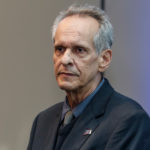











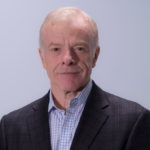







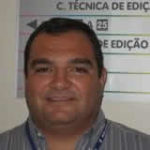
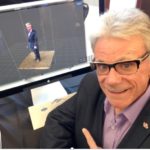





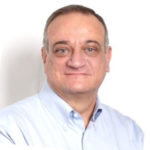

 This presentation will provide an insight into the experiences learned by several broadcasters who were early adopters of IP technology over the last few years. The presentation will focus on live sports production applications using outside broadcast (trucks) as well as remote production and large stand-alone facilities.
This presentation will provide an insight into the experiences learned by several broadcasters who were early adopters of IP technology over the last few years. The presentation will focus on live sports production applications using outside broadcast (trucks) as well as remote production and large stand-alone facilities.
